Pyramid 2000
An Interactive Fiction game for the TRS-80 and TRS-80 Color Computer
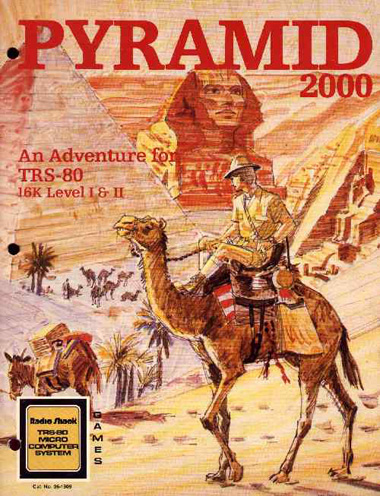 Cover of the TRS-80 Version of Pyramid 2000 |
 Cover of the TRS-80 Color Computer Version of Pyramid 2000 |
Pyramid 2000 TRS-80 Instructions | Pyramid 2000 TRS-80 Color Computer Instructions | Pyramid 2000 Solution
Where to play Pyramid 2000 on-line
You can play Pyramid 2000 right here! Thanks to Chris Cantrell for the code to make this work. Check out his Pyramid 2000 site http://computerarcheology.com/CoCo/Pyramid/
Pyramid 2000 TRS-80 version
The text area below is the virtual cassette tape. Instead of writing to tape, the emulator writes data as two-digit hex values to this text area.
The SAVE command will write 260 bytes (520 characters) to the text box. You must select all the characters (CNTRL-A) and copy them (CNTRL-C). Then store them in a text file for later use.
Before the LOAD command you must paste the desired saved-data back into the text area.
Pyramid 2000 CoCo version
The text area below is the virtual cassette tape. Instead of writing to tape, the emulator writes data as two-digit hex values to this text area.
The SAVE command will write 260 bytes (520 characters) to the text box. You must select all the characters (CNTRL-A) and copy them (CNTRL-C). Then store them in a text file for later use.
Before the LOAD command you must paste the desired saved-data back into the text area.
You can also play Pyramid 2000 in a web browser with the CoCo emulator called Mocha! http://www.haplessgenius.com/mocha/index.html?cassette=Pyramid. Type CLOADM at the CoCo prompt, wait for the game to load (this can take a few minutes) and then type EXEC when the CoCo prompt appears again and you are ready to play.
Pyramid 2016 - 3D and Virtual Reality versions
From the gamejolt.com website:Remember those days long ago when the idea of gaming was only text? Those adventure games that drove you nuts, typing in 2 words "go north", "Take Torch" etc... Frustrating you to no end trying to think of the right combination to just open the freakin door!Well here it is. The chance to actually FINISH one of those games, in true graphical style! No more 2 word commands, just point and click your commands!
This is a graphical remake of the 1978 Tandy game: Pyramid 2000. (I have been given the rights to use the name and recreate it)
We tried to stay as true to the text as possible, but due to not having a graphic artist we had to make do with what we could and it is progressing nicely! Currently it is only playable on PC. and in English.
Working on touchscreen controls for 'Convertible" laptops-Only windows based. (Other translations will be released as available) MAC/Linux have a few issues that should be easy enough to sort out once we have the PC completed.
The Pyramid 2016 PC demo is free at: http://gamejolt.com/games/pyramid-2016/197330
The Pyramid 2016 HTC VIVE Virtual Reality version is available on Steam: http://store.steampowered.com/app/556540
Pyramid 2000 Reviews
Be sure to check out Gaming After 40's blog and his playthrough of Pyramid 2000 - http://gamingafter40.blogspot.com/2014/01/adventure-of-week-pyramid-2000-1979.html.View the Pyramid 2000 source code
Please check out the Computer Archeology site that disassembles the Pyramid 2000 code and allows you to see exactly how the game designers created the program : http://computerarcheology.com/CoCo/Pyramid/
Pyramid 2000 Manuals
Download the PDF of the TRS-80 Pyramid 2000 Manual (First edition 1979): http://www.figmentfly.com/pyramid2000/pyramid2000-trs.pdf. (Thanks to the Museum of Computer Adventure Game History site at http://mocagh.org)
Download the PDF of the TRS-80 Pyramid 2000 Manual (Second edition 1981): http://www.figmentfly.com/pyramid2000/pyramid2000-trs2.pdf. (Thanks to the Museum of Computer Adventure Game History site at http://mocagh.org)
Download the PDF of the TRS-80 Color Computer Pyramid 2000 Manual : http://www.figmentfly.com/pyramid2000/pyramid2000-coco.pdf.
The text of both manuals can be found here : Pyramid 2000 TRS-80 Instructions and Pyramid 2000 TRS-80 Color Computer Instructions
The Solution to Pyramid 2000 can be found here : Pyramid 2000 Solution
Pyramid 2000 Game Roms
Download the Pyramid 2000 TRS-80 Game ROM here : http://www.figmentfly.com/pyramid2000/trs80roms/pyramid2000trs.zip
Download the Pyramid 2000 TRS-80 Color Computer Game ROM here : http://www.figmentfly.com/pyramid2000/cocoroms/pyramid2000coco.zip
Emulators
TRS-80
For PC Users : http://www.trs-80.com/wordpress/emulators/.
For Mac Users : http://macscene.net/
TRS-80 Color Computer
For PC Users : http://www.trs-80.com/wordpress/emulators/.
For Mac Users : http://www.haplessgenius.com/mocha/
Information about Pyramid 2000
The original part number for Pyramid 2000 on the TRS-80 was 26-1909 and the price was $14.95.The original part number for Pyramid 2000 on the Color Computer was 26-3310 and the price was $14.95 according to http://www.tim-mann.org/trs80/tandycat.txt.
Pyramid 2000 TRS-80 Instructions
Introduction
Before you lies the tip of the Great Lost Pyramid, its giant body concealed beneath a mountain of dry, shifting desert sand. Only the eroded tip stands as a mute tribute to the ancient ones-the builders of old, who wrought this silent crypt from stone dragged hundreds of miles under the ceaseless blazing heat of a contemptuous sun god.
The seal on the entrance is still unbroken-perhaps the tomb is still intact, untouched by the passage of time, impervious to the elements, still settled in quiet repose. There must be treasures. If even half of the stories about the Lost Pyramid are true. . . . . But why dwell on that now-you are here, and adventure awaits just a step away.
What? You say you've never used a computer to explore a pyramid before? Really, how interesting. That means you probably are not familiar with the Astral Projection technique that is required for exploration. Well, you look like an adventurous person, so I'll just briefly explain, and then you're on your own. The computer projects your Astral Image anywhere you wish, and you simply direct your image from the comfort of your keyboard. Of course you know that during the Astral Projection period; your Astral body is solid, vulnerable, and limited in understanding.
Because this technique is still new, there are many difficulties in using the procedure. For example, your Astral Image will only respond to one or two word commands, usually a verb and a noun (such as [GET LAMP]), or a verb and something else (such as [GO UP] or [GO EAST]). You will have to experiment to see which word combinations work. Usually directions can be just a single letter, such as [N] for North, [U] for Up, [NW] for Northwest, etc. You know, of course, that you must press [ENTER] after each complete command.
If you find treasures, you must return them to the entrance of the Pyramid in order to be credited with the discovery. Picking up a treasure within the Pyramid will earn you credits, but not as many as when you deposit the treasures at the entrance. To find the number of credits you have earned at any point, type [SCORE] and press [ENTER]. If you forget your location, simply type [LOOK] and press [ENTER] to find your present location. Type [INVENTORY] for a listing of the items you are currently holding.
There are certain key words that will help you on your great adventure. For instance, to pick something up, you might have to [GET] or [TAKE] it. Or you may have to [DROP] or [THROW] something. 'There is even a chance you might have to [CLIMB] once or twice, but where you do these z things, you will have td figure out for yourself Also, some things interact with others. For example, some objects cannot be caught because of something you might already be carrying-and some objects cannot he carried' until you [GET] a box to hold the object.
It won't be easy, but it will be fascinating and interesting. You might consider making a map as you explore each of the rooms and corridors in the Pyramid. It will save you from retracing your steps-it can't hurt, and it might help.
How to Save an Expedition
If you have to interupt your expedition, you may save your progress up to this point. When you start over, you will begin at the exact place you stopped, holding everything you had earlier. To save an expedition, you'll need a blank tape.
1. Remove the Pyramid Program tape.
2. Insert a blank, rewound tape in the cassette recorder.
3. Type [SAVE] and press [ENTER].
4. The screen will show READY CASSETTE.
5. Press the "PLAY" and "RECORD" buttons on the recorder.
6. Press [ENTER]. The expedition (up to this point) will be stored on
the blank tape. When the tape has finished storing where you are, what
you're carrying, and where you've been, you can rewind the tape for
later use, and continue exploring if you choose. If you turn your
computer off, you can always return to this point in the expedition by
using the Data tape you have just recorded.
Returning to a Previous Expedition
If you want to continue an expedition (from where you left off), follow these instructions:
1. Load the Pyramid Program tape (as described in the Loading
Instructions).
2. Remove the Program tape from the recorder. Press any key to start
the expedition.
3. Put the "Saved" Data tape in the recorder and make sure it is
rewound.
4. Press the "PLAY" button on the recorder.
5. Type [LOAD] and press [ENTER].
When the Data tape has loaded, the expedition will resume (with everything intact) at the point you left.
Pyramid 2000 TRS-80 Color Computer Instructions
Introduction
Before you lies the tip of the Great Lost Pyramid, its giant body concealed beneath a mountain of dry, shifting desert sand. Only the eroded tip stands as a mute tribute to the ancient ones-the builders of old, who wrought this silent crypt from stone dragged hundreds of miles under the ceaseless blazing heat of a contemptuous sun god.
The seal on the entrance is still unbroken-perhaps the tomb is still intact, untouched by the passage of time, impervious to the elements, still settled in quiet repose. There must be treasures. If even half of the stories about the Lost Pyramid are true. . . . . But why dwell on that now-you are here, and adventure awaits just a step away.
What? You say you've never used a computer to explore a pyramid before? Really, how interesting. That means you probably are not familiar with the Astral Projection technique that is required for exploration. Well, you look like an adventurous person, so I'll just briefly explain, and then you're on your own. The computer projects your Astral Image anywhere you wish, and you simply direct your image from the comfort of your keyboard. Of course you know that during the Astral Projection period; your Astral body is solid, vulnerable, and limited in understanding.
Because this technique is still new, there are many difficulties in using the procedure. For example, your Astral Image will only respond to one or two word commands, usually a verb and a noun (such as [GET LAMP]), or a verb and something else (such as [GO UP] or [GO EAST]). You will have to experiment to see which word combinations work. Usually directions can be just a single letter, such as [N] for North, [U] for Up, [NW] for Northwest, etc. You know, of course, that you must press [ENTER] after each complete command.
If you find treasures, you must return them to the entrance of the Pyramid in order to be credited with the discovery. Picking up a treasure within the Pyramid will earn you credits, but not as many as when you deposit the treasures at the entrance. To find the number of credits you have earned at any point, type [SCORE] and press [ENTER]. If you forget your location, simply type [LOOK] and press [ENTER] to find your present location. Type [INVENTORY] for a listing of the items you are currently holding.
There are certain key words that will help you on your great adventure. For instance, to pick something up, you might have to [GET] or [TAKE] it. Or you may have to [DROP] or [THROW] something. 'There is even a chance you might have to [CLIMB] once or twice, but where you do these z things, you will have td figure out for yourself Also, some things interact with others. For example, some objects cannot be caught because of something you might already be carrying-and some objects cannot he carried' until you [GET] a box to hold the object.
It won't be easy, but it will be fascinating and interesting. You might consider making a map as you explore each of the rooms and corridors in the Pyramid. It will save you from retracing your steps-it can't hurt, and it might help.
System Requirements
To enter the mystic world of Pyramid, you will need a 16K or 32K TRS-80 Color Computer, a color television, a Radio Shack cassette recorder, and connecting cables.
Loading the Program
Make sure that the Color Computer is properly connected to the television. Connect the tape recorder to the Color Computer. Insert the Pyramid tape and press the "Rewind" button on the tape recorder. Press "Stop" when the tape has finished rewinding. Turn on the Color Computer and television. Tune the television to channel 3 or 4. Press the "Play" button on your tape recorder.
Type [CLOADM] and press [ENTER]. A blinking F will appear in the upper left corner of the screen as the computer finds the program. When the OK appears on the screen, type [EXEC] and press [ENTER]. Now you can make your attempt to get through the Pyramid.
How to Save an Expedition
If you have to interrupt your expedition, you may save your progress up to this point. When you start over, you will begin at the exact place you stopped, holding everything you had earlier. To save an expedition, you'll need a blank tape.
Remove the Pyramid Program tape.
Insert a blank, rewound tape in the cassette recorder.
Type [SAVE] and press [ENTER].
The screen will show: READY CASSETTE -
Press the "Play" and "Record" buttons on the recorder.
Press [ENTER]. The expedition (up to this point) will be stored on the blank tape. When the tape has finished storing where you are, what you're carrying. and where you've been, you can rewind the data tape for later use, and continue exploring if you choose. If you shut your computer off, you can always return to this point in the expedition by using the Data tape you have just recorded.
Returning to a Previous Expedition
If you want to continue an expedition (from where you left] off), follow these instructions:
Load the Pyramid Program tape (as described in the Loading instructions).
Remove the Program tape from the recorder, press any key to start the expedition.
Put the "Saved" Data tape in the recorder and make sure it is rewound.
Press the "Play" button on the recorder.
Type [LOAD] and press [ENTER]
When the Data tape has loaded, the expedition will resume (with everything intact) at the point you left.
That is all I can tell you, since I really must be going. If I've forgotten anything, I'm afraid you'll just have to figure it out for yourself. Goodbye, good luck, and beware of the m . . . . . . . . . . . .
Pyramid 2000 Solution
This document below used to be on Steve McCoy's website at www.simology.com but his site no longer exists. When I realized this, I knew that I couldn't let the great knowledge from his site be lost. Luckily the Internet Archive Wayback Machine (http://www.archive.org/) allowed me to find his old web pages and post them here. I hope that other people get to enjoy these solutions as much as I did. Thank you Steve, wherever you are!
- Sean Murphy
Title: Pyramid 2000
Game type: Text-based adventure
Vendor: Radio Shack
Year Published: 1979
Solution by: Branden Robinson
Date: 4 October 1998
Email: branden@purdue.edu
WWW: http://www.ecn.purdue.edu/%7Ebranden/
Foreword
Pyramid 2000 was written by Robert Arnstein for Radio Shack, who needed some software to go with their TRS-80 Model I computers, which, along with the Apple II and (arguably) the Commodore PET, were in the vanguard of the home computer revolution which started in the late 1970's. Those computers are lodged in a niche between the kit computers much beloved of hobbyists (but which scared ordinary folks who didn't know what a soldering iron was for), and the commoditized, commercialized, Madison Avenue-ized Intel/Microsoft consortium whose ball really started rolling in 1981.
Most people who played it were unaware that Pyramid 2000 was not a wholly original creation. It borrowed very heavily from the original Crowther and Woods Colossal Cave adventure, which predated Pyramid by several years. Substitute a mummy for a pirate and a sarcophagus for a clam and you get an idea of how derivative a work Pyramid 2000 really is. Nevertheless, the game was easily enjoyable on its own merits, at least to the computer gaming audience of the late '70's and early '80's (let's face it, you couldn't exactly play Final Fantasy VII in 16 kB of RAM!).
I was first exposed to this game the year it was released, in 1979. It took me an embarassingly long time to solve it; the main factor, I think, being an obscenely dirty trick on the part of the author. Nevertheless, it's solved now, with the final clue being hammered into my head by Steve McCoy, so the game that followed me from a TRS-80 Model I, to a Color Computer 2, to Tim Mann's xtrs TRS-80 emulator, can be finally laid to rest. The number of people even interested in this game must be very small by now, but the number that know how to solve it is smaller still; hopefully this document will bring those groups into convergence. Needless to say, if the following doesn't look familiar to you:
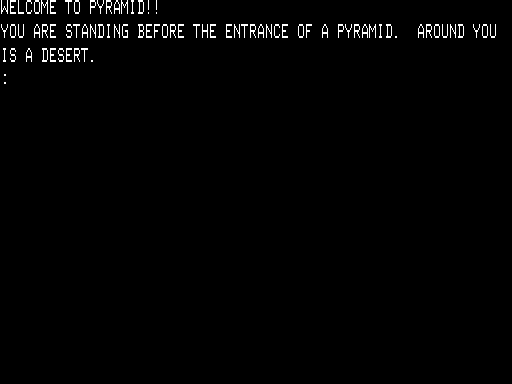
then you probably don't want to bother any further with this page. The rest of you are invited further into the pyramid to, at long last, uncover all its secrets (cue Raiders of the Lost Ark soundtrack)...
A step-by-step walkthrough, like Steve McCoy did for Haunted House and Raaka-Tu, would be very tedious for Pyramid 2000, where much of the time is simply spent moving through the very large map. Instead, I will take the approach of presenting a question-and-answer format, in approximate order of where particular obstacles present themselves in the game. Normally, for a FAQ-like resource such as this, I would include a list of all the questions before proceeding to the questions and answers, but on the off chance that anyone who's stuck really wants to try and solve the rest of the game on their own, I'm going to omit the summary, because the wording of some of the questions might spoil a surprise or two. A few of the answers will seem ridiculously obvious to some, but hey, I'm here to try to please everyone. Feel free to skip questions and answers that don't interest you -- that's what the scrollbar is for.
Those of you reading this page are probably retro-computing freaks; perhaps many of you never even finished this game. Take this opportunity to play it to completion! Have fun!
Part one -- outside the pyramid
Here is a map of the outside of the pyramid.
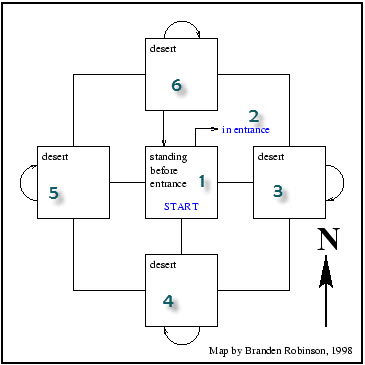
Image updated 2013 by Chris Cantrell
http://www.computerarcheology.com/wiki/wiki/CoCo/Pyramid
- Is there anything in the desert?
No. Don't waste your time looking for undiscovered treasure there. See the above map of the exterior of the pyramid to see how the desert works.
Part two -- inside the pyramid, "upper floor"
Actually there is quite a bit of up and down motion in this game, but as you'll see later, there is a convenient halfway point. Here's a map of the "first half" of the pyramid interior.
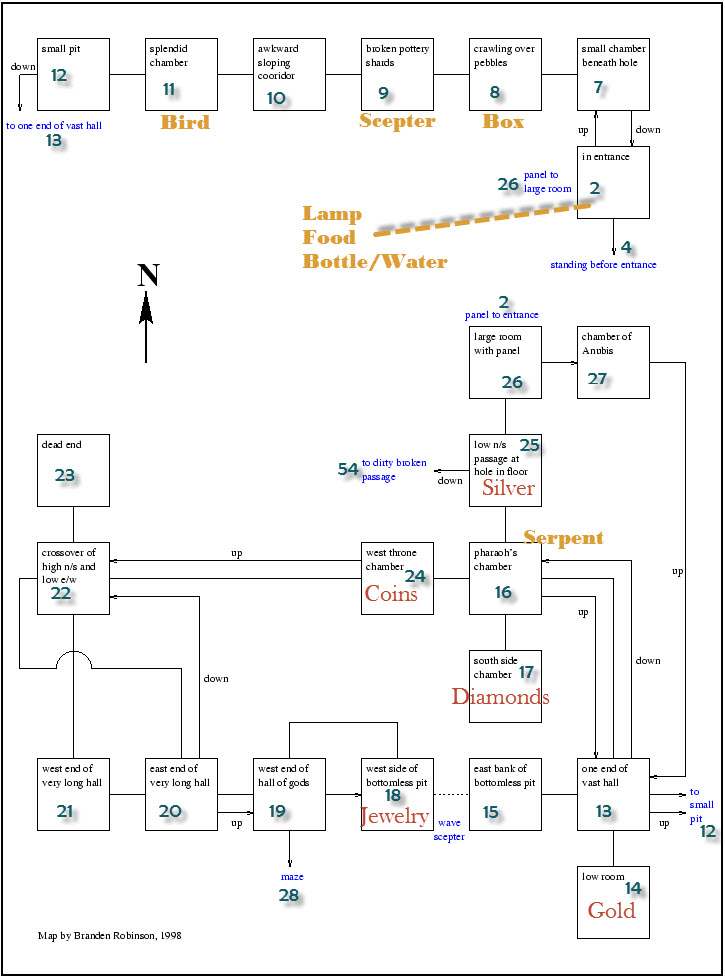
Image updated 2013 by Chris Cantrell
http://www.computerarcheology.com/wiki/wiki/CoCo/Pyramid
- What is the object of the game, and how do I score points?
You're a tomb robber! Your goal is to collect treasures from within the pyramid and return them to the entrance, where the lamp, food, and bottle are initially found. You receive five points for carrying a treasure (which, apart from an item being described with an exclamation point, is how you tell it's valuable), and twenty for dropping it back at the entrance. When you drop it, you lose the points for carrying it. The SCORE command and some quick math will tell you that there are eleven treasures in the game. If it takes you less than nineteen years to get them all, consider yourself more fortunate than your humble author. (Of course, I did do some other things in the meantime. Honest, I mean it!) You also lose ten points for every time you are killed in the game. Three strikes and you're out.
- It's pitch black and everywhere I go I fall into a pit
and break every bone in my body! What do I do?
Turn on the lamp, silly. Remember the shiny brass lamp in the entrance? ON LAMP works for me.
- I've been killed! Where's my stuff?
The lamp is returned, not to its original location, but to your original location, outside the entrance. It's also turned off. Your other items will be at the location where you died.
- How do I get the statue bird? I can lift it, but I can't
carry it!
The statue bird goes in the statue box. If you're carrying the statue box, you may pick up the statue bird. That is, of course, unless you're carrying something else...
- How do I get the statue bird? It comes to life and flies
away from me!
The statue bird does not like the scepter. Drop it. You can pick the scepter up again after you have the bird.
- How do I get the nugget of gold up the steps?
You don't. You can, however, go around the steps in two distinct ways. We'll get to that later.
- How do I get across the bottomless pit?
It's kind of funny how, when falling into a bottomless pit, you somehow manage to hit the bottom(!) and break every bone in your body. Or maybe Mr. Arnstein figured terminal velocity would grind your bones to powder. Anyway, if you WAVE SCEPTER on either side of the pit, it will cause a stone bridge to magically materialize and dematerialize. Don't worry, the bridge will never collapse out from under you.
- Help! I've wandered into a maze of twisty passages and I
can't get out!
Well, if you've only just wandered in there and not moved anywhere yet, or only tried to go north, there is help. Go up. If you're deeper in the maze, see part four, in which the maze is dissected. If you're this early in the game, though, the best thing to do is quit the game and restart. The maze is the last thing you need on your mind at this point.
- Help! Every time I pick up some treasure and go somewhere
with it, a mummy comes up and takes it away!
There are two ways of dealing with the mummy. The easy way is simply to not ever carry more than one treasure at a time. The hard way is to swallow your pride and let him take it. You'll learn, if you care to experiment, that he only bothers you once. After that, you can carry as much booty as you can fit in your arms, if you're lucky to find enough to fill them.
- How do I get past the huge fierce green serpent?
Well, there are two ways, actually. One is straightforward, and one is roundabout (cue the first track on Fragile).
Make sure you are carrying the statue bird. You are? Good. THROW BIRD. Enjoy it, that's the most action you'll see in this game -- the rest is logic puzzles.
For the roundabout way, see the next question.
- What's the story with that panel in the large room?
Simple -- it's just a shortcut to the entrance. GO PANEL to use it. In fact, you can use the panel from the very beginning of the game to "cheat" and get around the serpent (and "downstairs", into what I arbitrarily call the "second half" of the pyramid's interior), as I alluded to above. The serpent will still be a pain in the butt, though, since you can enter the pharaoh's chamber from any direction, but he always blocks your exit to the north, south, and west. He's kind of like a diode that way, I suppose. By the way, the panel is the first way to get the nugget of gold back to the entrance. The other comes much later, don't hold your breath.
- The rooms west of the pharaoh's chamber and west of the
bottomless pit don't make any sense!
It's a pain to get around in that part of the pyramid. I guess it's training ground for the maze, where things really get strange. My advice is to make a map, or use mine.
Part three -- inside the pyramid, "lower floor"
While making my map I noticed that the only way to avoid room overlap was to break it in pieces. A convenient place to do this is just to the north of the pharaoh's chamber, where there is a hole in the floor. Below that, I call the "lower floor". Also, on the upper floor, the treasures are just sitting out in normal rooms for you to grab them -- about half of the total of eleven. You have to work harder for the remaining six. At this point, you should have collected the gold, the jewelry, the coins, the silver bars, and the diamonds. Two of these may be in the possession of the mummy if you weren't careful. So grab a map (mine or your own) and work for those remaining treasures.
- Help! I'm trapped in the Land of the Dead!
"Those who proceed east may never return." Next time perhaps you'll listen! There is nothing of value in the Land of the Dead, so there's no reason to be there. It's also not a maze like the one with twisty passages, though it may seem like it. If you drop an item and move around you'll note the item always moves with you. There's your clue. The Land of the Dead is just one logical location, with exits that loop back on itself. The exit is selected randomly each turn, so eventually you'll get out if you keep moving. Shame on you if you dropped your lamp, a treasure, or some other useful item, and then got out without picking it back up! I think the author of this game left the Egyptian Weekly magazines outside in the Anteroom of Seker for a reason -- so the player would use that item figuring out the trick to the Land of the Dead.
- What do I do with the sarcophagus?
You can't do much with it (aside from observe a sudden lapse of grammar on the part of game's author). You can heft that heavy sucker up and down those vertical passages, but you can't get it out to the complex junction. My suggestion is to try opening it, and wonder about what might be inside. Maybe the mummy, resting in there like Dracula in his coffin (does the >GROAN< come from him, or your aching back?), and you can beat the bandages off of him when you get that thing open. Anyway, think hard about this one and we'll come back to it.
- What do I do in the chamber of Horus? Is there any point
to "exploring at random"?
Indeed there is, particularly north and up. If you keep attempting to go a direction, eventually you'll get somewhere besides a U-turn. See the map below for more information.
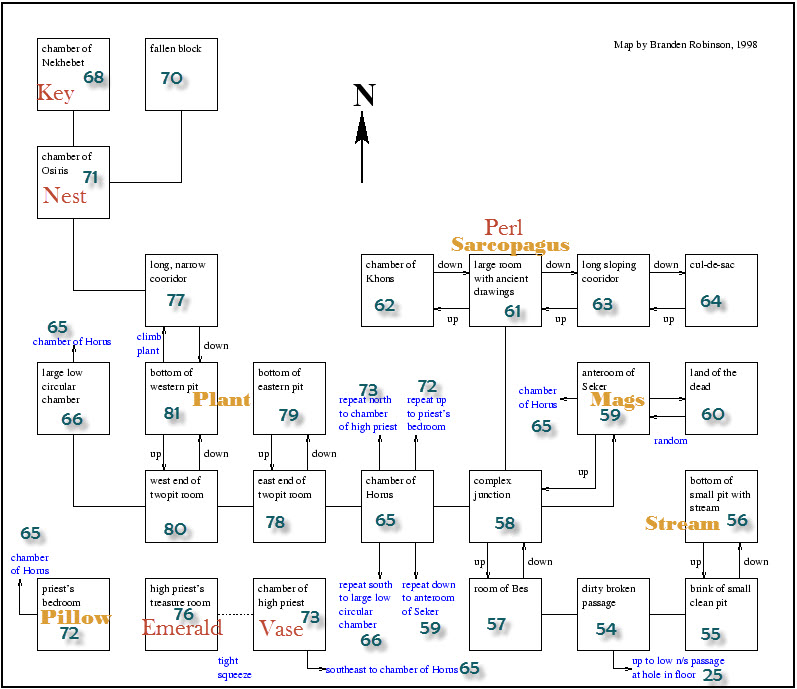
Image updated 2013 by Chris Cantrell
http://www.computerarcheology.com/wiki/wiki/CoCo/Pyramid
- How do I get through the tight squeeze in the chamber of
the high priest?
You have to drop everything. And I do mean everything, including that which is more precious even than treasure, that which stops you from falling into the ubiquitous pits and breaking every bone in your body. The lamp.
- I got the delicate, precious vase, but when I drop it
back at the entrance it breaks and I don't get any points for it!
Maybe you should drop it on something softer. You know, cushiony. Like a pillow. You mean you haven't been to the priest's bedroom?
- What's a plover?
It's a kind of bird. I don't know how big their eggs are, but I always imagine an ostrich egg. That should be big enough to tickle almost anyone's avarice.
- How do I get to the hole high up on the wall above the
west pit in the twopit room?
Well, if you've bothered to climb down into the west pit, you'll notice a plant there clubbing you over the head with a very unsubtle clue. What, you already drank the water yourself? Or have you found that one dousing of the plant isn't enough? Don't despair, if you've been an intrepid explorer you'll have found a small clean climbable pit where a tiny stream enters and exits through slits. It is there that you can FILL BOTTLE. You can then return to the plant, POUR WATER again, and then CLIMB PLANT to get to the hole that was formerly inaccessible.
- What do I do with the sarcophagus (revisited)?
Well, now that you've seen the chambers of Osiris and Nekhebet, perhaps it has occurred to you that the key can be used to unlock the sarcophagus. All you have to do is go to it and OPEN it.
- How do I keep the pearl from rolling away?
You don't (or it didn't really roll anywhere, if you had picked the sarcophagus up, and put it down in the right place.). However, the magic of the pyramid is not sufficient to defy gravity, so a good guess would be that the pearl rolled in such a manner as to minimize its gravitiational potential energy, right? So GO DOWN until you find it.
Part four -- the maze
Fourteen rooms with the same description -- "YOU ARE IN A MAZE OF TWISTY PASSAGES, ALL ALIKE.", twelve dead ends, and the brink of a pit. This thing is hell to map, but if you're up to some work, read on. Otherwise, keep handy a copy of my map and save yourself some sweat.
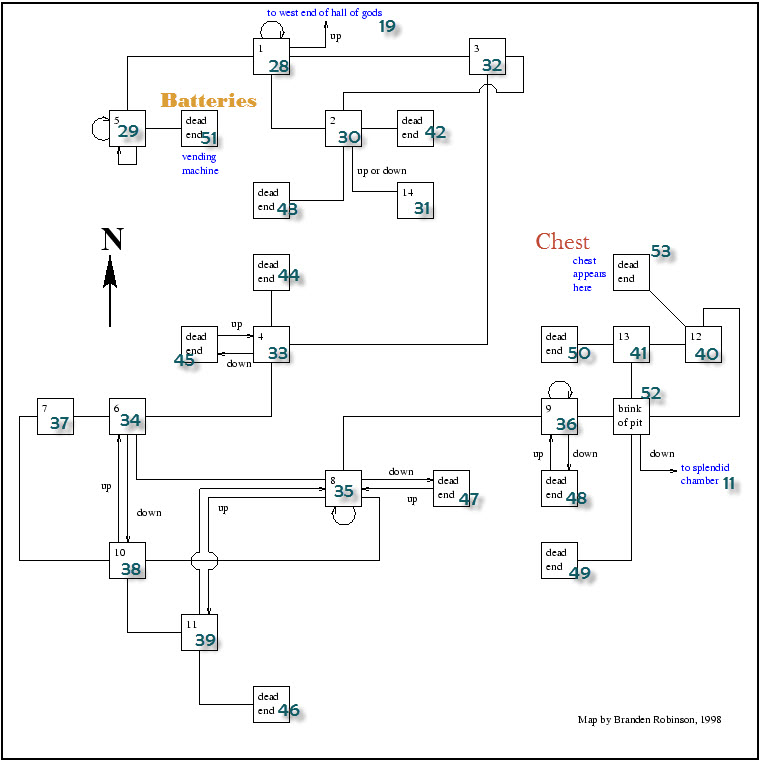
Image updated 2013 by Chris Cantrell
http://www.computerarcheology.com/wiki/wiki/CoCo/Pyramid
- My lamp is getting dim! Where's this vending machine?
If you've read this far, you're approaching the end of the game. I'll give you a hint, you can complete the adventure with maximum points in fewer turns than it takes to make the lamp go dim. I suggest quitting the game and economizing your moves. If you're bound and determined, however, you can use my map of the maze above, and see that the vending machine isn't too far in. If you have the coins with you you can DROP them at the location with the machine, and it will magically scoop them up and dispense some batteries. However, spending the coins means you can't get all the treasures, doesn't it?
- I've only been able to find ten treasures! What's the
eleventh?
Before you ask, no, it's not whatever laid those eggs. The eleventh treasure, as the mummy alluded, is the chest, deep in the maze. If you're up to it, you can map the maze yourself using the time-honored Hansel and Gretel trick. It's simple. Load up with items, enter the maze, and drop one. Then start moving. In some cases you'll find that going a particular direction actually takes you no place at all, because the item you dropped is in the "new" location. Rather than the dropped item moving with you, what's happened is that you've really stayed in the same place. When you are in a new maze location with no item in it, drop another. Then, as you move within the maze, you'll be able to tell the maze locations apart by what items they contain, and you can draw a map. Of course, you're bound to run out of items before you've finished mapping the maze, so you'll have to go back out and get some more. I'll give you one hint -- the dead ends really are dead ends, there is always only one way in or out of those, so don't bother dropping stuff in them. The maze is basically laid out along the primary compass points (N, S, E, W), but there a few places you can go up or down. And then there's the dirty trick the author of this game played that is Pure Evil...
- What's the supremely evil dirty trick about the maze?
There is one, and only one, place in the maze where a secondary compass point (as in northeast, southeast, etc.) is used. When you find it, you'll hit a dead end. Note the significance of this odd direction. Of course, if you let the mummy steal your treasure before you came here, the significance will be quite obvious. This piece of unadulterated sadism, teasing the player into not checking secondary compass points in the maze locations by having them completely eliminated except in this one place, is what added about twelve years to my solution time. I was still a kid, playing Pyramid on the CoCo, when I made my first "complete" map of the maze. Turns out it wasn't complete -- I didn't know about location fourteen on my map, which didn't really matter, and I didn't know about the oddball dead end, which matters quite a bit. I've heard over the years (there's also an old Dejanews article to this effect) that there is a specific sequence of moves you have to take to find the treasure chest in the maze; one wrong turn, and it vanishes until you leave the maze and try again. That's not exactly true, though it might as well be if you don't draw a map. You can run around in the maze as much you want -- the dead end will be in the same place, and so will the treasure chest, if applicable.
- Looking at your map makes my head spin. Come on, what's
the magic recipe for getting through the maze?
You really don't want to do any work, do you? Okay, okay:
To get to the treasure chest from maze location 1 on my map (go south from the west end of the Hall of Gods): E, S, S, S, N, E, E, NW
To get out of the maze from the treasure chest dead end using the pit: SE, N, D
To get out of the maze from the treasure chest dead end without using the pit: SE, N, W, W, W, E, E, W, U
- Yeah, well, I got to the secret northwest dead end, and
still no treasure chest! What's up?
You had to show a willingness to part with your treasure earlier (or just a reluctance to waste time running around with only one treasure at a time to avoid the mummy). The mummy has to steal your treasure, or there will be no treasure chest.
- Wait! What about the second way to get the gold around
the steps?
Climb down the pit in the maze. It's conveniently located near the secret dead end so you don't have to waste time backtracking through the maze all the way to the Hall of Gods.
You're done! Haul the last three treasures back to the entrance, drop them, and gaze upon your haul:
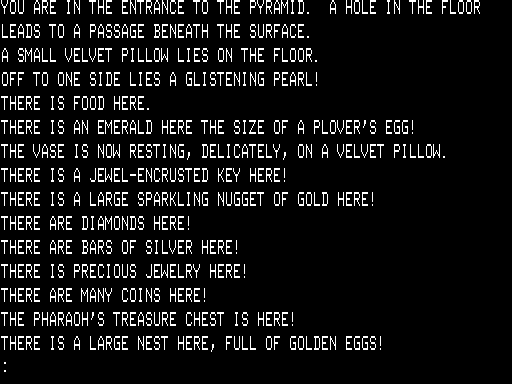
You don't get much of a congratulations, though:
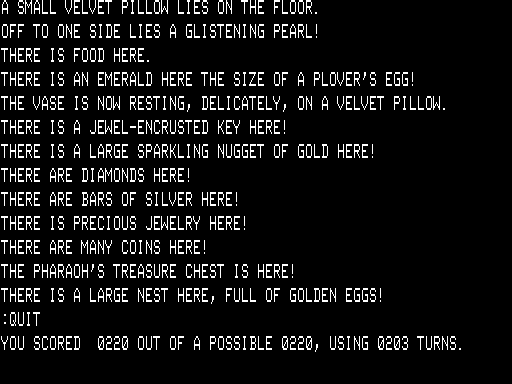
If the game author had shaved a few bytes off that damn maze, maybe he could have put in a nice little "congratulations!" message, but alas; you have to be content with your own satisfaction.
As a final irony, the size of this HTML file, not counting the inlined images, is larger than the original Pyramid 2000 executable. Just some food for thought, as quantities of RAM in the tens or even hundreds of megabytes becomes commonplace, and storage devices range into the tens of gigabytes. You kids today. Back when I got started with computers, we had only had 16 kilobytes of RAM, and the only "drive" we had was a cassette recorder that operated at 300 baud! Oh well, I'll shut up before some real old-timer starts yapping to me about punch cards, or someone has Charles Babbage's corpse exhumed and shipped to my door.
Bedlam Solution | Haunted House Solution | Madness and the Minotaur
Pyramid 2000 Solution | Raaka-Tu Solution | Xenos Solution
This document was last updated on 1/8/17.
Maintained by Sean Murphy (figment@figmentfly.com)